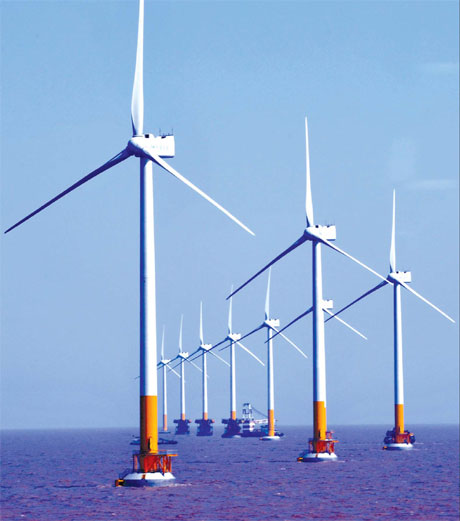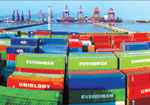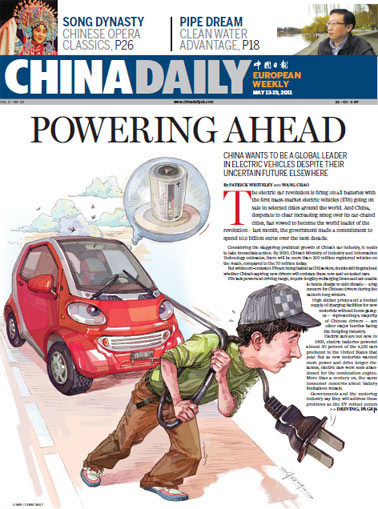Green China
Green revolution
Updated: 2011-01-28 11:01
By Shi Jing (China Daily European Weekly)
The wind energy sector is powering ahead in China
Standing tall among the trees in Huaihai Park in one of the busiest commercial districts of Shanghai is a modern windmill, put up by the city government as a statement of its environmental priorities. Similar to other cities and regions across the country, efforts in environmental improvement in Shanghai center on the development of alternative energy to power economic growth.
|
 China's rapidly expanding market for alternative power is attracting foreign companies which are leaders in the wind power generation sector. Zhang Ke / For China Daily |
As a result, China has become a leader in the use of wind power. Wind farms that occupy thousands of hectares of land are mushrooming in China, from the desert plains in the Xinjiang Uygur autonomous region to the rainforests on Hainan island. Windmills built with homegrown technology are also being exported to many foreign countries.
To tap the rapidly expanding Chinese market for alternative power, many foreign companies leading in this field have established manufacturing and research operations in Shanghai and other major cities. For example, Siemens of Germany has built a wind turbine blade production plant in Shanghai and the facility is considered the most advanced among all Chinese cities in harnessing wind as an energy source.
Wind power generated about 5 percent of the city's energy consumption. There are 21 wind power stations being built that use wind turbines supplied by Shanghai Electric and more than 400 wind power generation units have been installed, of which 300 sets have been connected to the power grid.
Shanghai Electric, which is also one of the largest diversified equipment manufacturing groups in China, is rapidly emerging as an important supplier of core wind power generator parts and complete wind power generation units. Its dominant position in the industry has established Shanghai as the center for wind power development and equipment production.
Speaking at the opening ceremony of the Siemen's Shanghai plant, Wolfgang Dehen, CEO of the Siemens Energy Sector and member of the managing board of Siemens AG, says the potential for growth in wind power in China is great.
"We see great potential for Siemens in Asia's wind market. With Shanghai being our hub for the Asia-Pacific, we are very well positioned to participate in this exciting growth market," Dehen says.
The 177,000-square-meter turbine blade manufacturing facility in Shanghai will initially produce blades for the company's 2.3 megawatt and 3.6 mW wind turbines. These blades will be made using a unique process patented by Siemens, without any glued joints that are susceptible to breakages.
The production capacity for the new facility is initially planned for 500 mW annually. The first 49-meter-long and 12-ton wind turbine blades left the plant at the end of 2010. The company has so far also offered jobs to about 120 employees in Shanghai, a number that is expected to grow to 210 by the end of 2011.
As Siemens' first manufacturing plant for wind turbine components in China, the factory has a designed annual production capacity of more than 600 wind turbine blades that will be able to more effectively meet the strong demand for wind turbine equipment in China as well as the export market. The total investment is about 35 million euros.
China has been doubling its installed wind power capacity each year since 2005. By 2020, total wind power generation is expected to reach 150 gigawatts, or three times the total wind power capacity of Europe.
"The global wind power market will grow from about 30 billion euros annually to as much as 216 billion euros by 2030," Dehen forecasts.
"We anticipate especially robust growth rates in China."
Since entering the wind power business in 2004, Siemens revenue has grown by 61 percent, resulting in a profit growth of 73 percent.
Siemens wind power became the No 1 in the market in 2009 for order backlogs and is on track to becoming one of the world's top three suppliers of wind turbines by 2012.
In Siemens' fiscal year 2009, revenue from its environmental portfolio totaled about 23 billion euros, making the group one of the world's largest supplier of eco-friendly technologies. In the same period, the company's products and solutions enabled customers to reduce their carbon dioxide emissions by 210 million tons, equal in amount to the combined annual carbon dioxide emissions of New York, Tokyo, London and Berlin.
In Shanghai, the major buyers of renewable energy are foreign-invested manufacturing enterprises. There is only one State-owned enterprise, Baosteel, among the top 10 users of renewable energy in the city.
This may be changing as the municipal government is stepping up its efforts to promote the use of clean energy with subsidies and other incentives.
The Golden Sun Project in the Shanghai Zhangjiang Hi-Tech Park, which is dedicated to the development of solar power generation, received a total of 200 million yuan (22.4 million euros) from Shanghai's municipal government. Shanghai Mayor Han Zheng says 65 percent of new residential buildings in the city will meet the city's energy saving criteria and the government will also accelerate the promotion of clean energy automobiles.
Shanghai Electric Group, one of the four owners of The Donghai Bridge Wind Farm project, announced in July 2010 the operation of this largest offshore wind farm outside Europe, which is capable of powering 200,000 households. The capacity of the wind farm was only 102 mW, less than 1 percent of the city's current total power capacity of about 18,200 mW from traditional fuel electric plants.
But Shanghai Electric says it marked a good start for the application of clean energy in Shanghai.
"The operation of the Donghai Bridge Wind Farm provided good experience for the development of new energy," says Li Chonghe, vice-general manager of Shanghai Electric.
The primary domestic wind turbine manufacturer in China is Goldwind from Xinjiang and takes up about 21 percent of the market share in 2010. But industry experts say these manufacturers are investing too little in research and development. For instance, Goldwind only set aside 1.6 percent of its 2009 revenue, or 177 million yuan, in R&D.
In contrast, Vestas Wind Systems, the world's largest manufacturer, seller, installer and service provider of wind turbines based in Denmark, spent about 249 million euros in R&D in 2009, which is more than 3.7 percent of its annual revenue.
"We can foresee the promising future of the wind energy market in China but also the gap between advanced international technologies," says Li Junfeng, secretary-general of the China Renewable Energy Industries Association.
"Generally speaking, wind power can take up about 10 percent of an entire power grid. But China's target is to reach 30 percent by 2050."
E-paper

War of the roses
European Chinese rose growers are beating their Chinese rivals at their own game
Preview of the coming issue
High-tech park gets big boost
At the source
Specials

New wave
Coastal city banks on marine sector to ride next stage of economic development

Drunk driving
Drunk drivers face a detention for one to six months and a revokation of their drivers' license.

V-Day parade
A military parade marking the 66th anniversary of the Soviet victory over Nazi.
